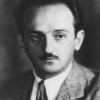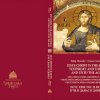Обрад Милићевић, родом из села Звјерине у Херцеговини, где не успева ништа друго сем Херцеговаца, одлучи да се 1922. пријави за жандара у Билећи. Прође све испите.
Био је здрав к'о дрен, паметан, поштен и храбар, погађао је у мету, трчао брже од осталих, руковао сабљом и бајонетом, бацао најдаље камена с рамена, није пушио ни пио, а био је, као што се зна, из добре фамилије...
.На крају, пошто га примише у жандаре, требало је да потпише решење, али он одби да то учини.
"Зашто нећеш да потпишеш?", упиташе га.
"Не умијем", одговори. "Нијесам писмен".
"Како, јадан, нијеси... писмен? Па како ћеш писати пријаве и записнике кад се што деси?"
И тако га и поред свега не примише у жандаре, те се он исели у Америку, куда отпутова италијанским шипом Сан Ђовани ди Месина из луке Котор, где је неки Дубровчанин, по имену Балтазар Гради, сакупљао Херцеговце за рад у рудницима Бјут Монтане.
Као што каже стара пословица: "Херцеговина сав свијет насели, а себе опет не расели."
После многих потуцања, Обрад, којем су у Невјорку уписали ново име О'Брајен, тражећи место слично родној Звјерини, насели се на северозападу државе Аризоне, према граници Калифорније, испод планине Кросман. Живео је сиромашно бавећи се оним чим се бавио и на Звјерини - узгајао овце чије је месо продавао у оближњем граду Хаваса Ситију. Држава Аризона му дала сто јутара потпуно неплодне земље за симболичну цену од пет долара.
Једнога дана док је копао велику рупу да направи чатрњу, исту онакву као што је имао у Херцеговини (у том крају није било друге воде сем кишнице), изненада потече нафта. Постао је тако богат преко ноћи. Саградио је пространу кућу у колонијалном стилу, а за своју душу подигао једну сасвим малу, камену, као што је била она у којој се родио, са огњиштем, гредама и овнујским кожама на којима је спавао сањајући Звјерину.
И тако, дође и дан да се његова компанија споји са Стандард ојл компанијом, која је из Феникса послала чувеног адвоката да се потпишу уговори. Али он одби да стави свој потпис!
"Због чега нећете да потпишете уговор?", упита га запањени адвокат.
"Нијесам писмен", одговори он.
"Господине О'Брајен", рече адвокат, "ви сте један од најбогатијих људи у Аризони. Шта бисте тек постали да сте знали да пишете!"
"Постао бих жандар у Билећи", одговори Обрад.
Момо Капор
Momčilo Momo Kapor (Serbian Cyrillic: Момчило Момо Капор; 8 April 1937 – 3 March 2010) was a Serbian novelist and painter. Kapor is the author of over forty novels, short stories, travel and autobiographic books and essays. He was introduced to the literary circles as the author of radio, TV and theater drama at the beginning of the sixties. His novels are on national bestseller lists. Kapor's books are translated to twenty languages. The shorts stories collection Kinoteka at three and novels The green felt of Montenegro and The last flight to Sarajevo were published in French by L'Age d'homme, Lausanne and The Mastery of Slomovic by Xenie, Vevey, Switzerland. Kapor is also the author of several screenplays. His paintings were exhibited in New York, Boston, Geneva, Frankfurt, London and other cities. He has also illustrated his own and numerous books by other authors.
Momo Kapor was a regular member of the Academy of Science and Arts of the Republic of Srpska.
Kapor was born in 1937 in Sarajevo, Drina Banovina, Kingdom of Yugoslavia. His father, Gojko Kapor, was a poor bank clerk, and his mother, Bojana was a housewife. In 1941, during World War II, a bomb fell on the home in which Kapor, his grandmother, and his mother were taking refuge. Kapor’s mother used her body as a shield and, although she was killed, Kapor was able to survive. He reflected back on that day, remembering that even the little cat, which he held in his arms, died. Kapor knew very little about his mother since not much was said in his family. Immediately following World War II, Kapor moved with his family to Belgrade, Serbia where he remained there for majority of his life.
As a young man, Kapor studied painting at the Academy of Art in Belgrade under the guidance of Professor Nedeljko Gvozdenović. Although, Kapor graduated with a degree in painting, he had grown fond of writing as a young boy. Therefore, while studying art he also occupied his time with news writing. Kapor would write news articles and interviews and then accompany his writing with his own representative portrait or illustration. It is through this method that Kapor was able to combine his two greatest passions he had in life, painting and writing.
Kapor is one of the most popular Serbian writers, whose literary phenomenon has spread over three decades. Kapor easily attracted the attention of the public by writing his constant reflections on the reality of the current time. The generations of people from former Yugoslavia were connected through Kapor's writings which have become best sellers in Zagreb's house of "knowledge" and its famous library "hit".
Kapor also wrote many documentary films, television shows, and novel.s His novels, "Una" and "The Book of Complaints" were made into films. These films have been translated into many languages including: French, German, Polish, Czech, Bulgarian, Hungarian, Slovenian, and Swiss. His most famous works include, "Ada", "Zoe", "From Seven to Three", and "The Chronicle of a Lost City".
Kapor has exhibited many of his paintings across various countries such as in the United States, Germany, and France. The reason he preferred to showcase his artwork in foreign countries rather than in Belgrade was that he did not enjoy the "art climate" set in Belgrade. He felt that many great artists in Belgrade were forgotten, whereas in other countries, a new emerging artist does not "erase" those who came before him/her.
After having two surgeries, Kapor died from throat cancer on March 3, 2010.
List of Works
- Foliranti, 1975.
- Provincijalac, 1976.
- Ada, 1977.
- Lanjski snegovi, 1977.
- Hej, nisam ti to pričala, 1978.
- Zoe, 1978.
- Beleške jedne Ane (hronika u 26 glava), 1978.
- Skitam i pričam: putopisni dnevnik, 1979.
- 101 priča, 1980.
- Una: ljubavni roman, 1981.
- Onda, 1982.
- Sentimentalno vaspitanje, 1983.
- Knjiga žalbi, 1984.
- 011-Istok-Zapad, 1990.
- Halo, Beograd, 1990.
- Dama skitnica i off priče, 1992.
- Zelena čoja Montenegra, 1992.
- Blokada 011, 1992.
- 100 nedelja blokade, 1994.
- Lero – kralj leptira, 1995.
- Poslednji let za Sarajevo, 1995.
- Hronika izgubljenog grada, 1996.
- Od sedam do tri, 1996.
- Smrt ne boli: priče iz poslednjeg rata, 1997.
- Najbolje godine i druge priče, 1997.
- Ivana, 2001.
- Legenda o Taboru, 2002.
- Sanja, 2003.
- Čuvar adrese
- Dosije Šlomović
- Konte
- Lep dan za umiranje
- Ljubavne priče
- Samac
- Uspomene jednog crtača
- Eldorado
- Putopis kroz biografiju
From Wikipedia





